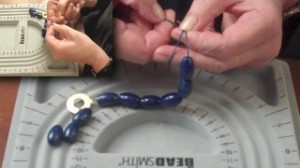Knotting between Pearls and Beads is Foundational
When I taught pearl and bead stringing classes at my gallery, which I did for more than ten years, occasionally I’d have a student who was content to stop after learning how to crimp. This, fortunately, did not happen frequently, but it did happen.
Crimping, of course, is a method of stringing beads where a flexible wire is inserted through the beads to create a string of beads. The wire is then folded over the jump ring of the clasp and through a metal tube. The metal is then smashed against the wire to secure the necklace to the clasp. There have been improvements in crimping technology over the years, notably the introduction of the crimping pliers which allows the user to fold the metal over the original “smash,” adding strength and durability to the connection to the clasp.
Crimping is an essential skill. It is also the easiest skill to learn. Although I don’t often crimp necklaces, I do when the beads present a manufacturing issue which I can’t solve without crimping. These include beads with exceptionally large drill holes such as those you’ll often encounter with amber and beads with very small drill holes which won’t accommodate even the thinnest thread. You’ll sometimes see these tiny holes with very porous materials, such as lava.
But I always look for a way around crimping.
Why?
The basic benefits of knotting between pearls and beads are well understood.
- Knotting prevents the beads from rubbing against one another. This is especially important for organic gemstones such as pearls and for other gemstones which can scratch relatively easily.
- Knotting helps prevent loss. Should a necklace break, the probability is that only one pearl or gemstone will be at risk of being lost. The knots keep the other gemstones from scattering.
- Knotting between pearls and beads sends an unmistakable signal to a client or buyer that the pearl and bead stringer cared enough about the finished product to put the time and effort into a professional and durable manufacturing process. When I see a necklace that isn’t knotted, red flags go up in my mind. Are the gemstones so inexpensive that the manufacturer didn’t feel that they warranted knotting? Is the necklace commercially produced, that is produced in large quantities? And, if I see an unknotted necklace at a truck show or craft show or fair, then I always suspect that the manufacturer just hasn’t taken the time to learn how to knot.
I once had a student who asserted that it wasn’t important to learn how to knot, that clients wouldn’t see or understand its benefits. Unlike most of my students who went on to do very good work that I was proud of, this student didn’t last long in the Houston design community. Clients, especially clients who buy art jewelry or one-of-a-kind jewelry are exceptionally discerning. Believe me, they know when a necklace is badly strung or the manufacture is shoddy. Short-cuts with this crowd just don’t cut it.
Although the benefits of knotting between pearls and beads are well-understood, these benefits don’t stop there. Knotting is essential for securely attaching a necklace to a clasp, for increasing manufacturing capabilities and as an critical element in design. More on this tomorrow.


